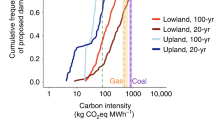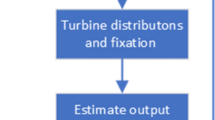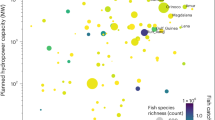Abstract
Given growing energy demands and continued interest in hydropower development, it is important that we rethink hydropower to avoid detrimental socioenvironmental consequences of large dams planned in regions such as the Amazon River basin. Here, we show that ~63% of total energy planned to be generated from conventional hydropower in the Brazilian Amazon could be harnessed using in-stream turbines that use kinetic energy of water without requiring storage. At five of the nine selected planned dam sites, the entirety of energy from planned hydropower could be generated using in-stream turbines by using only a fraction of the river stretch that large dams would affect. We find the cost (US$ kWh−1) for in-stream turbines to be ~50% of the conventional hydropower cost. Our results have important implications for sustainable hydropower development in the Amazon and worldwide through transition to power generation methods that meet energy needs while minimizing the negative socioenvironment impacts.
This is a preview of subscription content, access via your institution
Access options
Access Nature and 54 other Nature Portfolio journals
Get Nature+, our best-value online-access subscription
$29.99 / 30 days
cancel any time
Subscribe to this journal
Receive 12 digital issues and online access to articles
$119.00 per year
only $9.92 per issue
Buy this article
- Purchase on Springer Link
- Instant access to full article PDF
Prices may be subject to local taxes which are calculated during checkout



Similar content being viewed by others
Data availability
All input datasets used in the analyses are publicly available from the cited references. Processed data required to reproduce the figures in the main text are available on CUAHSI HydroShare and Figshare (https://doi.org/10.6084/m9.figshare.13366118).
Code availability
All figures were produced using the freely available visualization libraries in Python 3.5 (such as Matplotlib). The relevant portions of the computer code used to process the results and develop the figures are available at https://doi.org/10.5281/zenodo.4382186.
References
Renewable Capacity Highlights (International Renewable Energy Agency, 2019); https://www.irena.org/-/media/Files/IRENA/Agency/Publication/2019/Mar/RE_capacity_highlights_2019.pdf
Renewable Energy Highlights (International Renewable Energy Agency, 2019); https://www.irena.org/-/media/Files/IRENA/Agency/Publication/2019/Jul/IRENA_Renewable_energy_highlights_July_2019.pdf
Moran, E. F., Lopez, M. C., Moore, N., Müller, N. & Hyndman, D. W. Sustainable hydropower in the 21st century. Proc. Natl Acad. Sci. USA 115, 201809426 (2018).
Gernaat, D. E. H. J., Bogaart, P. W., Vuuren, D. P. V., Biemans, H. & Niessink, R. High-resolution assessment of global technical and economic hydropower potential. Nat. Energy 2, 821–828 (2017).
Winemiller, K. O. et al. Balancing hydropower and biodiversity in the Amazon, Congo, and Mekong. Science 351, 128–129 (2016).
Pokhrel, Y., Shin, S., Lin, Z., Yamazaki, D. & Qi, J. Potential disruption of flood dynamics in the Lower Mekong River Basin due to upstream flow regulation. Sci. Rep. 8, 17767 (2018).
Pokhrel, Y. et al. A review of the integrated effects of changing climate, land use, and dams on Mekong River Hydrology. Water 10, 266 (2018).
Stone, R. Dam-building threatens Mekong fisheries. Science 354, 1084–1085 (2016).
Fearnside, P. M. & Pueyo, S. Greenhouse-gas emissions from tropical dams. Nat. Clim. Change 2, 382 (2012).
O’Connor, J. E., Duda, J. J. & Grant, G. E. 1000 dams down and counting. Science 348, 496–497 (2015).
Timpe, K. & Kaplan, D. The changing hydrology of a dammed Amazon. Sci. Adv. 3, e1700611 (2017).
Latrubesse, E. M. et al. Damming the rivers of the Amazon basin. Nature 546, 363–369 (2017).
Forsberg, B. R. et al. The potential impact of new Andean dams on Amazon fluvial ecosystems. PLoS ONE 12, e0182254 (2017).
Finer, M. & Jenkins, C. N. Proliferation of hydroelectric dams in the Andean Amazon and implications for Andes-Amazon connectivity. PLoS ONE 7, e35126 (2012).
Anderson, E. P. et al. Fragmentation of Andes-to-Amazon connectivity by hydropower dams. Sci. Adv. 4, eaao1642 (2018).
Pokhrel, Y. et al. Model estimates of sea-level change due to anthropogenic impacts on terrestrial water storage. Nat. Geosci. 5, 389–392 (2012).
Eiriksdottir, E. S., Oelkers, E. H., Hardardottir, J. & Gislason, S. R. The impact of damming on riverine fluxes to the ocean: a case study from Eastern Iceland. Water Res. 113, 124–138 (2017).
Yang, H. F. et al. Erosion potential of the Yangtze Delta under sediment starvation and climate change. Sci. Rep. 7, 10535 (2017).
Cochrane, S. M. V., Matricardi, E. A. T., Numata, I. & Lefebvre, P. A. Landsat-based analysis of mega dam flooding impacts in the Amazon compared to associated environmental impact assessments: upper Madeira River example 2006–2015. Remote Sens. Appl. Soc. Environ. 7, 1–8 (2017).
Fearnside, P. M. Impacts of Brazil’s Madeira River dams: unlearned lessons for hydroelectric development in Amazonia. Environ. Sci. Policy 38, 164–172 (2014).
VanZwieten, J. et al. In-stream hydrokinetic power: review and appraisal. J. Energy Eng. 141, 04014024 (2014).
Pokhrel, Y. N., Oki, T. & Kanae, S. A grid based assessment of global theoretical hydropower potential. Annu. J. Hydraul. Eng. 52, 7–12 (2008).
Zhou, Y. et al. A comprehensive view of global potential for hydro-generated electricity. Energy Environ. Sci. 8, 2622–2633 (2015).
Hoes, O. A. C., Meijer, L. J. J., Van Der Ent, R. J. & Van De Giesen, N. C. Systematic high-resolution assessment of global hydropower potential. PLoS ONE 12, e0171844 (2017).
Bryden, I. G. & Couch, S. J. ME1—marine energy extraction: tidal resource analysis. Renew. Energy 31, 133–139 (2006).
Karsten, R., Swan, A. & Culina, J. Assessment of arrays of in-stream tidal turbines in the Bay of Fundy. Philos. Trans. R. Soc. A 371, 20120189 (2013).
Malki, R., Masters, I., Williams, A. J. & Nick Croft, T. Planning tidal stream turbine array layouts using a coupled blade element momentum—computational fluid dynamics model. Renew. Energy 63, 46–54 (2014).
Vennell, R., Funke, S. W., Draper, S., Stevens, C. & Divett, T. Designing large arrays of tidal turbines: a synthesis and review. Renew. Sustain. Energy Rev. 41, 454–472 (2015).
Assessment and Mapping of the Riverine Hydrokinetic Energy Resource in the Continental United States Report No. 1026880 (Electrical Power Research Institute, 2012).
Ortega-Achury, S., McAnally, W., Davis, T. & Martin, J. Hydrokinetic Power Review (Mississippi State Univ., 2010).
Garrett, C. & Cummins, P. The efficiency of a turbine in a tidal channel. J. Fluid Mech. 588, 243–251 (2007).
Garrett, C. & Cummins, P. Limits to tidal current power. Renew. Energy 33, 2485–2490 (2008).
Miller, G., Franceschi, J., Lese, W. & Rico, J. The Allocation of Kinetic Hydro Energy Conversion Systems (KHECS) in USA Drainage Basins: Regional Resource and Potential Power (USDA,1986).
Chaudhari, S., Pokhrel, Y., Moran, E. F. & Miguez-Macho, G. Multi-decadal hydrologic change and variability in the Amazon River Basin: understanding terrestrial water storage variations and drought characteristics. Hydrol. Earth Syst. Sci. 23, 2841–2862 (2019).
Pokhrel, Y. N., Fan, Y., Miguez-Macho, G., Yeh, P. J. F. & Han, S. C. The role of groundwater in the Amazon water cycle: 3. Influence on terrestrial water storage computations and comparison with GRACE. J. Geophys. Res. Atmos. 118, 3233–3244 (2013).
Ten-Year Energy Expansion Plan 2029 (Ministry of Mines and Energy, 2019).
Ansar, A., Flyvbjerg, B., Budzier, A. & Lunn, D. Should we build more large dams? The actual costs of hydropower megaproject development. Energy Policy 69, 43–56 (2014).
Petheram, C. & McMahon, T. A. Dams, dam costs and damnable cost overruns. J. Hydrol. X 3, 100026 (2019).
Awojobi, O. & Jenkins, G. P. Were the hydro dams financed by the World Bank from 1976 to 2005 worthwhile? Energy Policy 86, 222–232 (2015).
Previsic, M., Bedard, R. & Polagye, B. System Level Design, Performance, Cost and Economic Assessment—Alaska River In-stream Power Plants (EPRI, 2008).
Copping, A. E. & Hemery, L. G. OES-Environmental 2020 State of the Science Report: Environmental Effects of Marine Renewable Energy Development Around the World (USDOE, 2020); https://doi.org/10.2172/1632878
Davidson, E. A. et al. The Amazon basin in transition. Nature 481, 321–328 (2012).
Lovejoy, T. E. & Nobre, C. Amazon tipping point. Sci. Adv. 4, eaat2340 (2018).
Malhi, Y. et al. Climate change, deforestation, and the fate of the Amazon. Science 319, 169–172 (2008).
Miguez-Macho, G. & Fan, Y. The role of groundwater in the Amazon water cycle: 1. Influence on seasonal streamflow, flooding and wetlands. J. Geophys. Res. Atmos. https://doi.org/10.1029/2012JD017539 (2012).
Shin, S., Pokhrel, Y. & Miguez-Macho, G. High resolution modeling of reservoir release and storage dynamics at the continental scale. Water Resour. Res. 55, 787–810 (2019).
Pokhrel, Y. et al. Incorporating anthropogenic water regulation modules into a land surface model. J. Hydrometeorol. 13, 255–269 (2012).
Pokhrel, Y. N., Fan, Y. & Miguez-Macho, G. Potential hydrologic changes in the Amazon by the end of the 21st century and the groundwater buffer. Environ. Res. Lett. 9, 084004 (2014).
Yamazaki, D., Oki, T. & Kanae, S. Deriving a global river network map and its sub-grid topographic characteristics from a fine-resolution flow direction map. Hydrol. Earth Syst. Sci. 13, 2241–2251 (2009).
Lehner, B., Verdin, K. & Jarvis, A. New global hydrography derived from spaceborne elevation data. Eos 89, 93–94 (2008).
Coe, M. T., Costa, M. H. & Howard, E. A. Simulating the surface waters of the Amazon River basin: impacts of new river geomorphic and flow parameterizations. Hydrol. Process. 22, 2542–2553 (2008).
Mulligan, M., Saenz-Cruz, L., van Soesbergen, A., Smith, V. T. & Zurita, L. Global Dams Database and Geowiki Version 1 (Geodata, 2009); http://geodata.policysupport.org/dams
Zarfl, C., Lumsdon, A. E., Berlekamp, J., Tydecks, L. & Tockner, K. A global boom in hydropower dam construction. Aquat. Sci. 77, 161–170 (2015).
Guney, M. S. Evaluation and measures to increase performance coefficient of hydrokinetic turbines. Renew. Sustain. Energy Rev. 15, 3669–3675 (2011).
Shin, S. et al. High resolution modeling of river–floodplain–reservoir inundation dynamics in the Mekong River Basin. Water Resour. Res. 56, e2019WR026449 (2020).
Previsic, M. Cost Breakdown Structure for River Current Device (Sandia National Laboratory, 2012).
Renewable Power Generation Costs in 2019 (International Renewable Energy Agency, 2019); https://www.irena.org/-/media/Files/IRENA/Agency/Publication/2020/Jun/IRENA_Power_Generation_Costs_2019.pdf
Gridded Population of the World v.4 (CIESIN, 2016); https://doi.org/10.7927/H4SF2T42
Acknowledgements
We acknowledge the funding from the National Science Foundation (INFEWS, award no. 1639115 and CAREER, award no. 1752729) and the Environmental Science and Policy Program (ESPP) at Michigan State University. Model simulations were conducted at Cheyenne (https://doi.org/10.5065/D6RX99HX) provided by NCAR’s Computational and Information Systems Laboratory sponsored by the National Science Foundation. None of these agencies or funding sources should be held responsible for the views herein. They are the sole responsibility of the authors.
Author information
Authors and Affiliations
Contributions
Y.P. and S.C. designed the research framework. S.C. conducted numerical simulations and S.C. and Y.P. analysed the results. S.C., E.B., R.Q.-A., Y.P. and N.M. developed the mathematical framework for the estimation of in-stream hydropower potential and cost comparison. E.M. contributed intellectually to the implementation of the project. S.C. prepared all graphics. All authors discussed and interpreted the results. S.C. and Y.P. wrote the manuscript. All authors discussed, commented on and edited the manuscript.
Corresponding author
Ethics declarations
Competing interests
The authors declare no competing interests.
Additional information
Peer review information Nature Sustainability thanks Simone Athayde and the other, anonymous, reviewer(s) for their contribution to the peer review of this work.
Publisher’s note Springer Nature remains neutral with regard to jurisdictional claims in published maps and institutional affiliations.
Supplementary information
Supplementary Information
Supplementary Figs. 1–8, Tables 1–3 and references.
Rights and permissions
About this article
Cite this article
Chaudhari, S., Brown, E., Quispe-Abad, R. et al. In-stream turbines for rethinking hydropower development in the Amazon basin. Nat Sustain 4, 680–687 (2021). https://doi.org/10.1038/s41893-021-00712-8
Received:
Accepted:
Published:
Issue Date:
DOI: https://doi.org/10.1038/s41893-021-00712-8
This article is cited by
-
Hydropower expansion in eco-sensitive river basins under global energy-economic change
Nature Sustainability (2024)
-
Wake characteristics in high solidity horizontal axis hydrokinetic turbines: a comparative study between experimental techniques and numerical simulations
Journal of the Brazilian Society of Mechanical Sciences and Engineering (2024)
-
Fish response to the presence of hydrokinetic turbines as a sustainable energy solution
Scientific Reports (2023)



